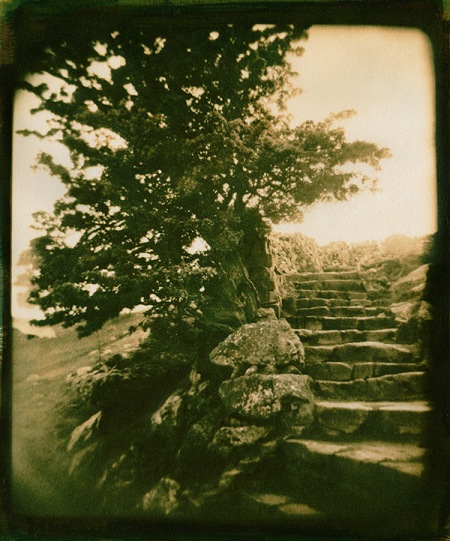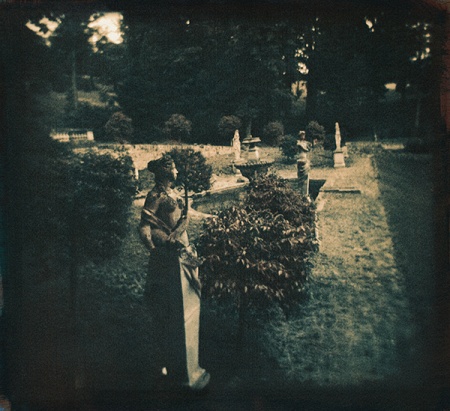
Judy F. Sherrod and S. Gayle Stevens, Nocturnes 2, wet plate collodion pinhole tintype, 20 in x 20 in., 2012
Our Nocturnes series began as an experiment, an adventure, a collaboration. A pinhole camera-maker and a wet-plate collodion artist collaborated to produce mammoth plate tintypes, echoing the work and process of the early survey photographers. Carleton Watkins, William Henry Jackson, and Timothy O’Sullivan, surveying the expansive landscape of the western US, found themselves at the mercy of nature.

Judy F. Sherrod and S. Gayle Stevens, Nocturnes 1, wet plate collodion pinhole tintype, 20 in x 20 in., 2012
James McNeill Whistler, inspired by the visual melody he found in dark skies and seas, titled many of his paintings nocturnes. In turn, these paintings provided inspiration for the orchestral nocturnes written by Debussy, musical impressions which ebb and flow.

Judy F. Sherrod and S. Gayle Stevens, Nocturnes 24, wet plate collodion pinhole tintype, 20 in x 20 in., 2012
Inspired by these artists and the waters of the gulf in Pass Christian Mississippi we too found ourselves at the mercy of the tides, our images determined by the capriciousness of the water before us.

Judy F. Sherrod and S. Gayle Stevens, Nocturnes 3, wet plate collodion pinhole tintype, 20 in x 20 in., 2012
Because of its infinite depth of field, the pinhole camera conveys the vast expanse of the sea while the collodion-silver emulsion flows across the plate like the waves across the sand. The plates delivered an unexpected serendipity – a daytime nighttime, a sunny moonscape.

Judy F. Sherrod and S. Gayle Stevens, Nocturnes 11, wet plate collodion pinhole tintype, 20 in x 20 in., 2012
There is ebb and flow between night and day, dark and light, as silent sentinels watch waves writing verse in the sand. This push and pull of tides, this melody of the waves, this lyric creates a visual dialogue that is the inspiration for Nocturnes, a little night music.

Judy F. Sherrod and S. Gayle Stevens, Nocturnes 21, wet plate collodion pinhole tintype, 20 in x 20 in., 2012
One year ago, Judy Sherrod and S. Gayle Stevens embarked on a new adventure, a collaboration entitled Nocturnes, born of the gulf in Pass Christian, Mississippi. Stevens, a wet plate collodion artist, and Sherrod, a pinhole camera maker, joined together to create something not done before: mammoth plate pinhole wet plate tintypes. They have been very successful at it. Their collaboration has resulted in such publications as South by Southeast magazine and Lenscratch, and will be included in the next edition of Christopher James, The Book of Alternative Photographic Processes. Exhibitions include: Alternative Processes at the Center for Fine Art Photography in Fort Collins, where they were awarded both the Director’s and the Juror’s Honorable Mention, Beheld at Homespace Gallery, Call and Response at New Orleans Photo Alliance Gallery, Center Forward, V at Homespace, Currents 2012 at the Ogden Museum of Southern Art, and Sun to Moon Gallery, among others. Over the course of a year, the duet shot forty-nine twenty-by-twenty inch pinhole tintypes of the gulf.










































